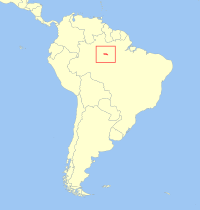Pied tamarin
| Pied tamarin | |
|---|---|
 |
|
| Scientific classification | |
| Kingdom: | Animalia |
| Phylum: | Chordata |
| Class: | Mammalia |
| Order: | Primates |
| Family: | Callitrichidae |
| Genus: | Saguinus |
| Species: | S. bicolor |
| Binomial name | |
|
Saguinus bicolor (Spix, 1823) |
|
 |
|
| Geographic distribution | |
The pied tamarin (Saguinus bicolor) is an endangered primate species found in a restricted area in the Brazilian Amazon Rainforest.
This New World monkey is found within and just north of the city limits of Manaus, the capital of the Amazonas state of Brazil. The main distribution is in the rio Cuieiras and rio Preto da Eva interfluvium. Pied tamarins are also found in the adjacent rio Preto da Eva and rio Urubu interfluvium, but are comparatively rare. There appears to be interspecific competition between the pied tamarin and the red-handed tamarin with the red-handed tamarin gradually displacing the pied tamarin from areas of its historical distribution. There are therefore multiple threats to the long-term survival off the pied tamarin that stem from habitat destruction and from interspecific competition.
The pied tamarin's body measures 20.8–28.3 cm.; including the tail it measures 33.5–42.0 cm. Males weigh 428 grams (n = 4). Its life expectancy is approximately 10 years in the wild.
Individuals live in groups of 2 to 15 members with little intra-group competition. Average group size in the Reserva Florestal Adolpho Ducke is 4.8 individuals per group (n = 41), and other areas around Manaus reported mean group sizes of 6.19 ± 2.62 (n = 46).
Only the alpha female of the group will breed. Reproduction in other females of the group is behaviorally suppressed. The gestation lasts 140–170 days and mothers typically give birth to twins. Young tamarins are cared for primarily by the father and turned over to the mother only to nurse; however, the entire group helps with the care of the young.
...
Wikipedia

